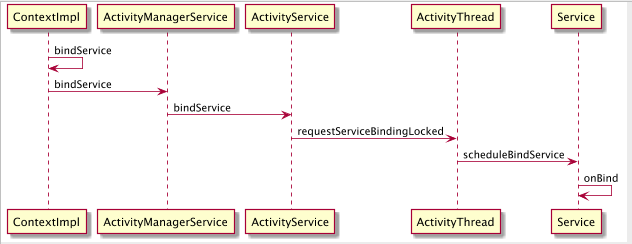1.前言
上一篇看了activity的启动流程,过程非常复杂,代码的细节都没多看,我们初学者,知道大体的流程就可以了。以后在慢慢看吗。今天来看下,service的流程,因为activiy涉及到activiy栈,所以比较难,但是我们的service不涉及,所以流程相对简单点。
我们启动service分为两种情况
- startService
- bindService
我们分开来看。我们知道Activity是Context,而Context的实现是ContextImpl,因此,我们从ContextImpl说起。
2.startService的方式
2.1 ContextImpl#startServiceCommon
在startService方法中,直接调用startServiceCommon,这个方法的核心代码如下:
|
|
ActivityManagerNative.getDefault(),为binder客户端,上篇说到过。
在AMS中,客户端bp端为ActivityManagerNative的内部类,ActivityManagerProxy,服务端bn端对ActivityManagerService。
因此,我们略过bp端,无非就是向其中数据,然后transact。我们直接看bn端对应的方法。
2.2 ActivityManagerService#startService
在这个方法中,并没有过多的操作,而是将操作传递给ActivityService,
|
|
2.3 ActivityService#startServiceLocked
在这个方法中,经过进程检验、service注册检查、ServiceRecord属性设置等一系列操作之后,调用startServiceInnerLocked方法
2.4 ActivityService#startServiceInnerLocked
|
|
在这个方法中,后续操作交由bringUpServiceLocked处理。
2.5 ActivityService#bringUpServiceLocked
在这个方法中,有两种情况:
- 需要的进程存在
- 需要的进程不存在
当service需要的进程存在的时候,如果,service已经存在了,那么通过sendServiceArgsLocked方法的后续操作调用onStartCommand,如果不存在,则调用realStartServiceLocked进程create操作。
如果需要的进程不存在,则需要fork进程,这个后面的文章在说。
解析来我们直接看realStartServiceLocked操作吧。
2.6 ActivityService#realStartServiceLocked
改方法核心代码;
|
|
这样,通过调用ApplicationThread的对应方法,H类捕获CREATE_SERVICE消息,通过handleCreateService,来创建service。
2.7 ActivityThread#handleCreateService
|
|
- 构造service
- 关联application
- 调用onCreate 执行
就这样,一个全新的service就启动了。
3.bindService的方式
这种方式会中甲调用直到ActivityService的bindServiceLocked方法,这个方法里首先会通过bringUpServiceLocked去船舰service,和我们上面一样,这个方法最后会调用requestServiceBindingLocked,requestServiceBindingLocked核心代码如下;
|
|
随后会在activitythread中,调handleBindService方法,去执行service的onbind方法,具体的就不说了。
4.上图
这里只是简单的介绍了流程,很多细节的东西并没有看。

